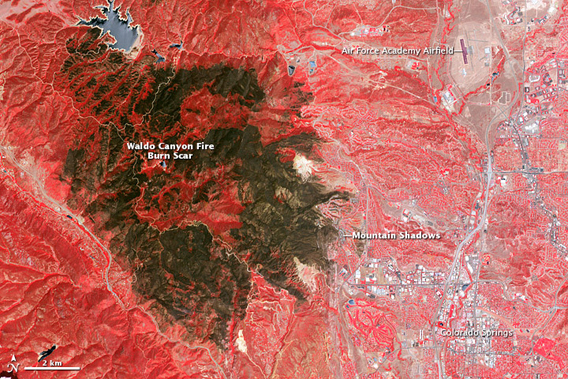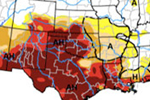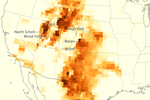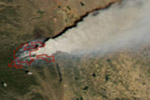
Fire scar from Waldo Canyon Fire in Colorado. Photo by: NASA.
According to new data from the National Oceanic and Atmospheric Administration (NOAA)’s National Climatic Data Center, the last twelve months have been the warmest on record for the contiguous United States. This record, set between July 2011 through June 2012, beat the last consecutive twelve month record set only a month earlier between June 2011 and May 2012, which in turn beat the previous record holder, you guessed it: May 2011 through April 2012.
June 2012, according to the NOAA, was the 14th warmest on record, but followed the warmest spring yet recorded in the U.S. IN addition, a heatwave at the very end of June shattered records across the country, including many set during the Dust Bowl. Two states, South Carolina and Georgia, may have even beat their all time warmest temperatures, an anomaly in June. In addition over half of the U.S. (56 percent) was under drought conditions. This is the largest percentage of drought recorded in the U.S. since monitoring began 12 years ago. Devastating and massive fires also swept through the Southwest, including the biggest fire ever in New Mexico and Colorado’s two most destructive fires ever: the High Park Fire and Waldo Canyon Fire, which killed two people and destroyed 350 homes. The landmark heatwave, drought, and natural disasters, have pushed many in the media, as well as a number of researchers, to connect the dots between these bizarre records and global climate change.
“Many people around the world are beginning to appreciate that climate change is under way, that it’s having consequences that are playing out in real time and, in the United States at least, we are seeing more and more examples of extreme weather and extreme climate-related events,” the chief of NOAA Jane Lubchenco recently said in a speech in Australia. “People’s perceptions in the United States at least are in many cases beginning to change as they experience something first-hand that they at least think is directly attributable to climate change.”
Since the U.S. makes up only two percent of the world’s land surface, it shouldn’t be seen as a proxy for global trends. However, as the world warms due to climate change, the U.S. can hardly escape its many predicted impacts. Scientists have long warned that climate change will increase the odds, and in some cases boost the ferocity, of extreme weather events like heatwaves, droughts, floods, and wildfires. In fact, a study released this week found that climate change made the devastating drought in Texas last year 20 times more likely. With time, researchers will also most likely tease out if climate change boosted the probability of the U.S.’s current heatwave.
“What we’re seeing really is a window into what global warming really looks like,” Princeton University climatologist Michael Oppenheimer recently said. “It looks like heat. It looks like fires. It looks like this kind of environmental disasters.”
Related articles
Climate change increased the probability of Texas drought, African famine, and other extreme weather

(07/11/2012) Climate change is here and its increasing the chances for crazy weather, according to scientists. A prestigious group of climatologists have released a landmark report that makes the dramatic point that climate change is impacting our weather systems—and in turn our food crops, our economies, and even our lives—here-and-now. The new report in the American Meteorological Society is first of what is intended to be an annual offering that will attempt to tease out the connections between climate change and individual extreme weather events, such as heatwaves, droughts and floods.
Scientist: ‘no doubt’ that climate change is playing a role in U.S. fires

(07/02/2012) A noted climate scientist says there is ‘no doubt’ that climate change is ‘playing a role’ in this year’s series of record fires in the western U.S. A massive wildfire in Colorado has forced the evacuation of 36,000 people, destroyed over 300 homes, and killed two people. The devastation wrought by the Waldo Canyon Fire even prompted a visit form U.S. President Barack Obama. But this is not the only epic fire in the U.S. this year: less than a month before the Colorado disaster, New Mexico experienced its largest fire on record in Gila Nation Forest; the conflagration burned up 247,000 acres (100,000 hectares). Other major wildfires have occurred in Utah and Wyoming, as well as other parts of New Mexico and Colorado.
Second warmest May yet worldwide
(06/18/2012) Last month was the second warmest May since record-keeping of global temperatures began 132 years ago. Globally, temperatures were 0.66 degrees Celsius (1.19 Fahrenheit) above the 20th Century Average and were only topped by May 2010, according to preliminary findings by the National Oceanic and Atmospheric Administration (NOAA).
U.S. undergoes warmest spring on record
(06/12/2012) Spring in the U.S. was the warmest on record, beating the past record-year (1910), by a stunning two degrees Fahrenheit, according to new data from the National Oceanic and Atmospheric Administration (NOAA). The data also shows that the past 12 months–from June 2011 through May 2012–was the warmest on record in the contiguous U.S. as well.
As Colorado and New Mexico burn, scientists say prepare for more

(06/12/2012) A massive wildlife in Colorado still burns after it has killed one person and damaged or destroyed over a hundred structures. The fire, the third largest in Colorado’s history, has burned 39,500 acres (16,000 hectares) to date. Meanwhile in central New Mexico, another wildfire has damaged or destroyed 35 structures and burned 34,500 acres (14,000 hectares). This comes just weeks after New Mexico’s largest wildfire ever—still going—burned up over 247,000 acres (100,000 hectares) of the Gila Forest. Weeks of heroic efforts by thousands of firefighters have contained this megafire by only 37 percent to date. Now, a new scientific study in Ecospshere has found that North America and Europe must prepare for even more fires as global temperatures continue to rise from climate change.
As La Nina ends, world experiences 5th warmest April
(05/21/2012) La Nina conditions, which generally bring colder temperatures to many parts of the world, ended last month resulting in the fifth warmest April since record-keeping began, and the hottest April yet in the terrestrial Northern Hemisphere, according to the National Oceanic and Atmospheric Administration (NOAA).
U.S. undergoes warmest 12 months yet
(05/10/2012) Americans would not be remiss in asking, “is it getting hot in here?” According to new data from the National Oceanic and Atmospheric Administration (NOAA)’s National Climatic Data Center, the last twelve months (from May 2011 through April 2012) were the warmest on record for the lower 48 U.S. states since record keeping began in the late 19th Century.
U.S. suffers warmest March, breaking over 15,000 record temperatures
(04/11/2012) March was the warmest ever recorded in the U.S. with record-keeping going back to 1895, according to new data by the National Oceanic and Atmospheric Administration (NOAA). But the month wasn’t just a record-breaker, it was shockingly aberrant: an extreme heatwave throughout much of the eastern and central U.S. shattered 15,272 day and nighttime records across the U.S. In all March 2012 was 0.5 degrees Fahrenheit above the previous warmest March in 1910, and an astounding 8.6 degrees Fahrenheit above the 20th Century average for March in the U.S.